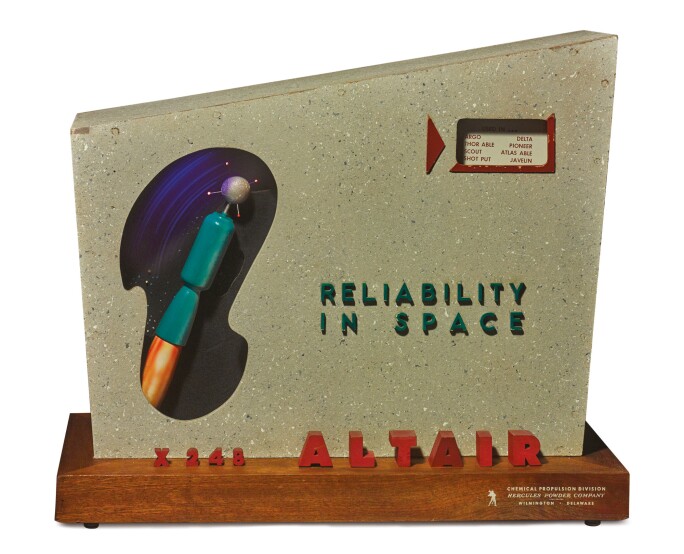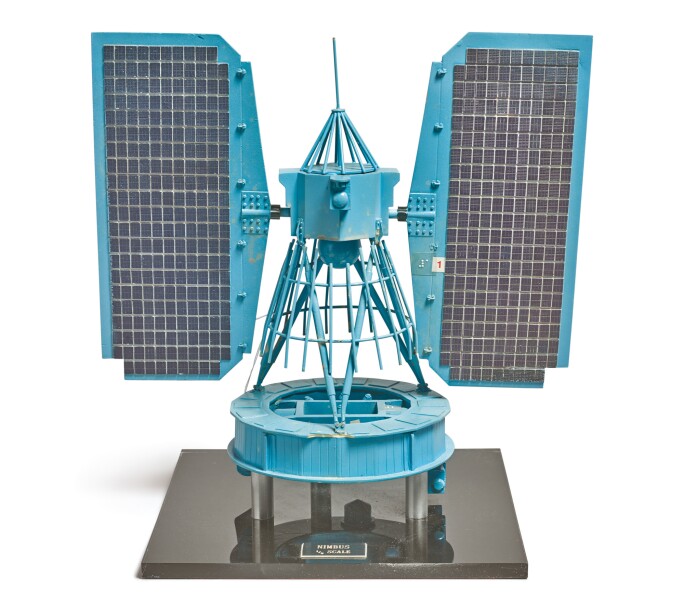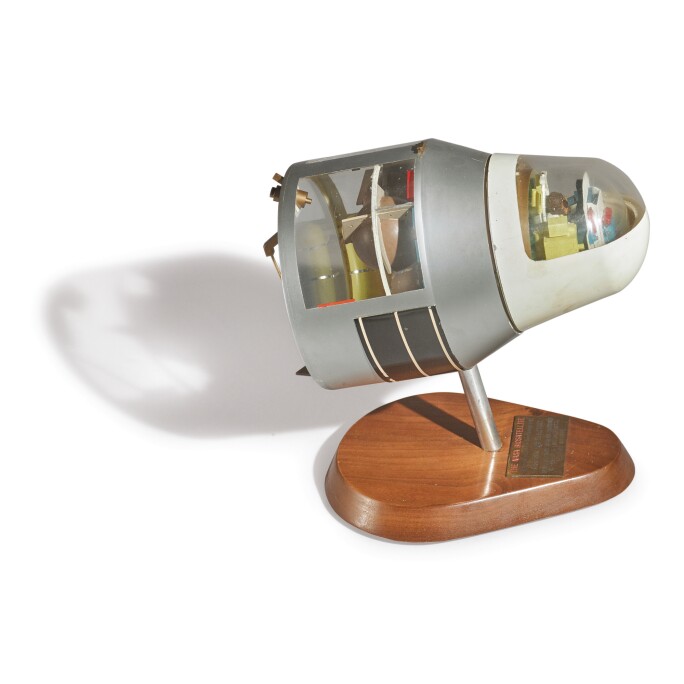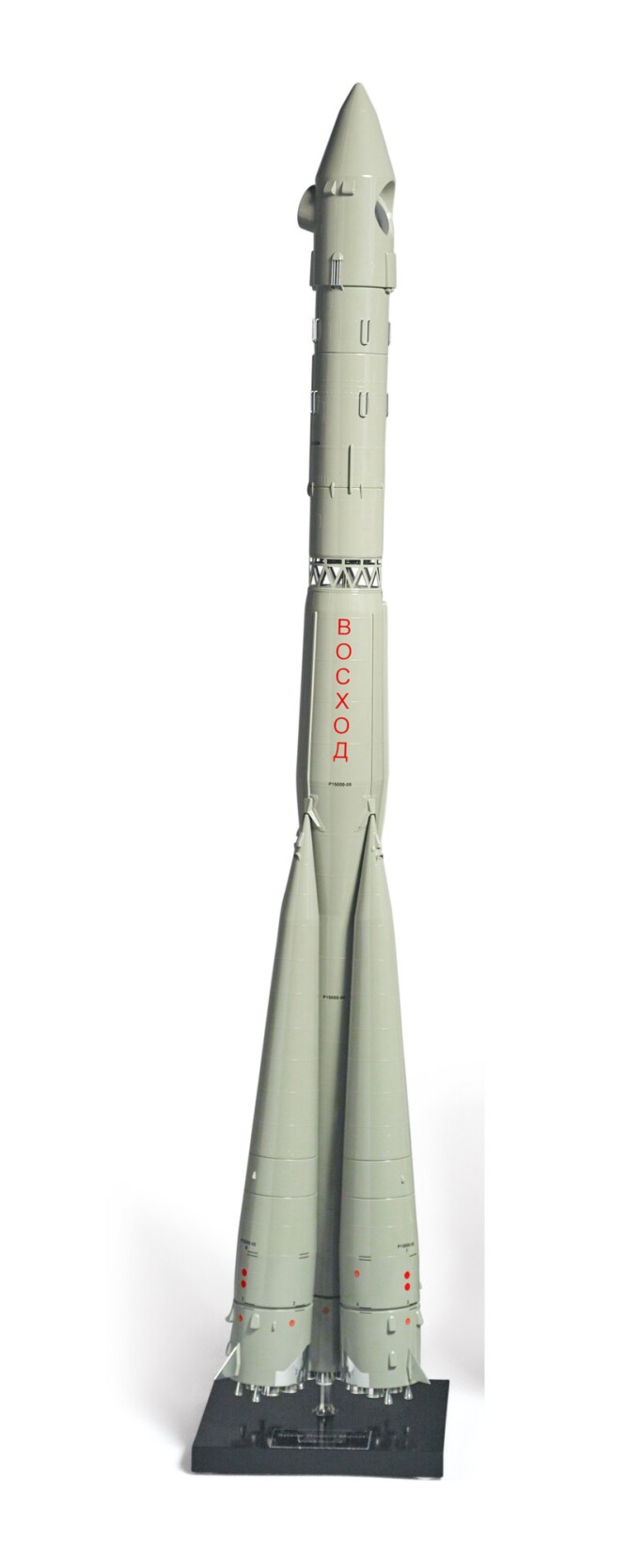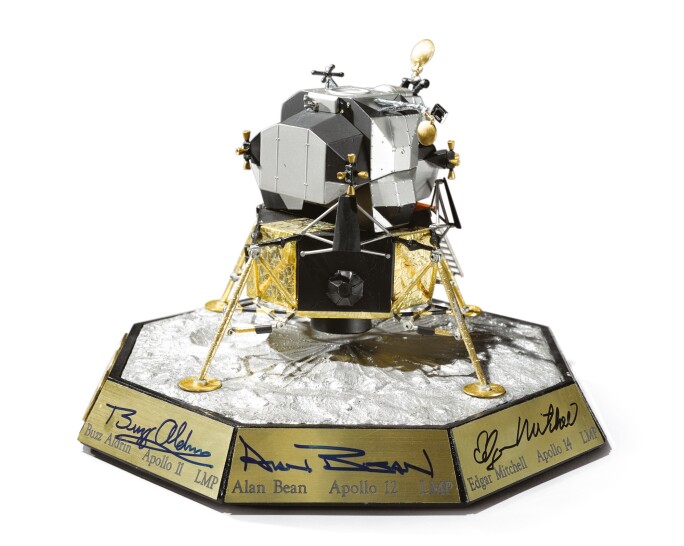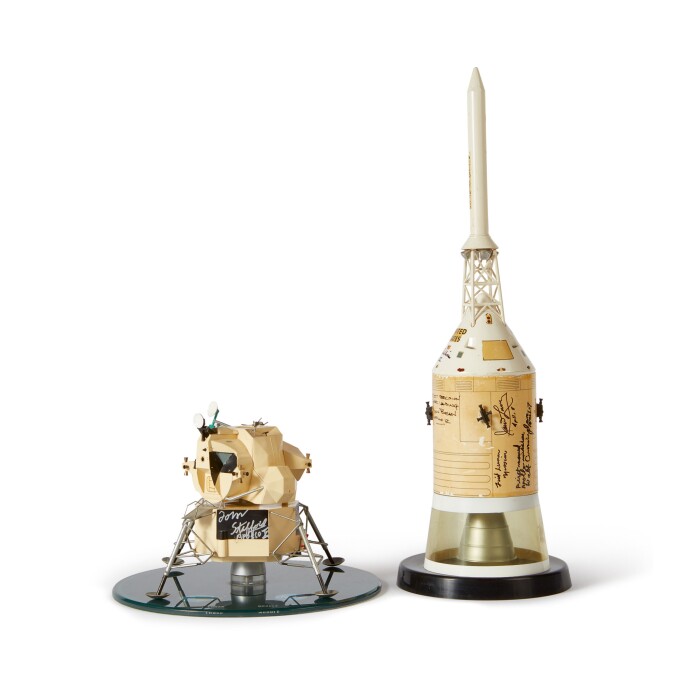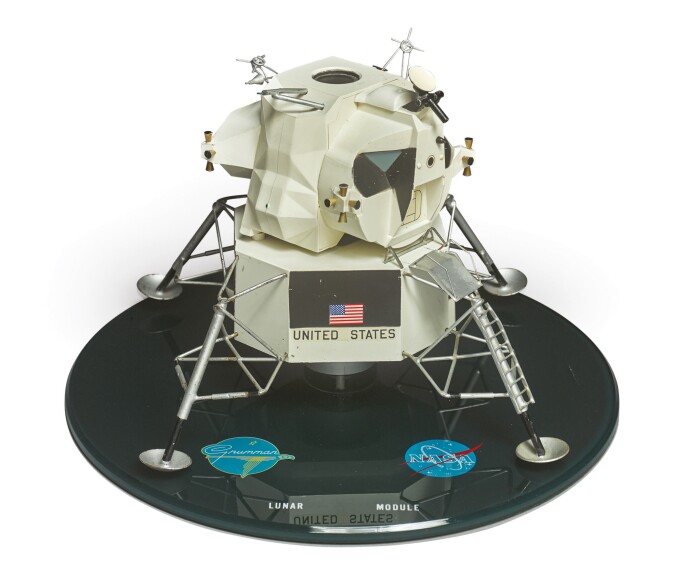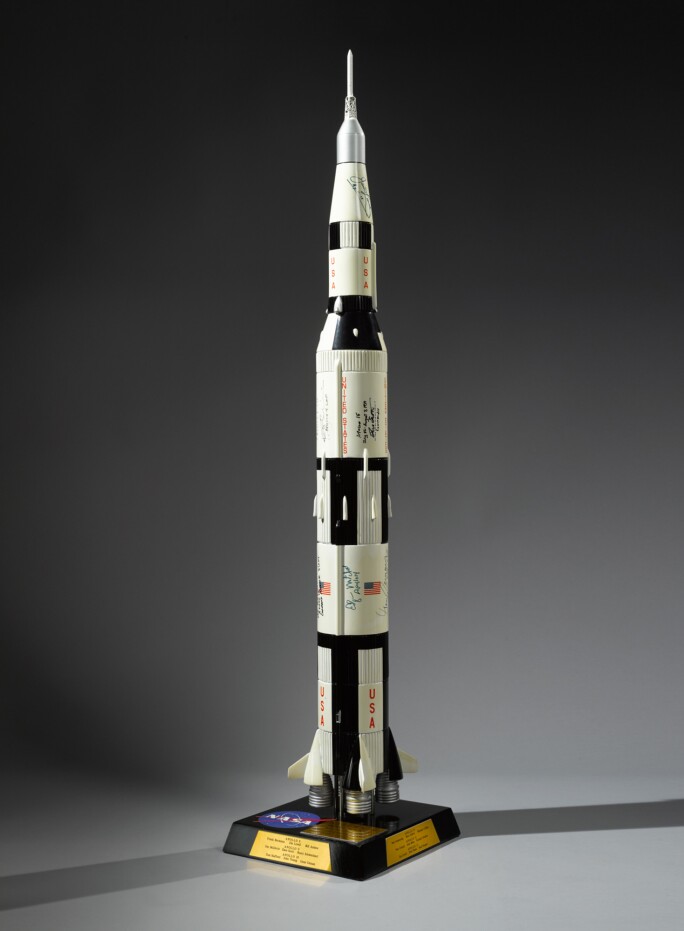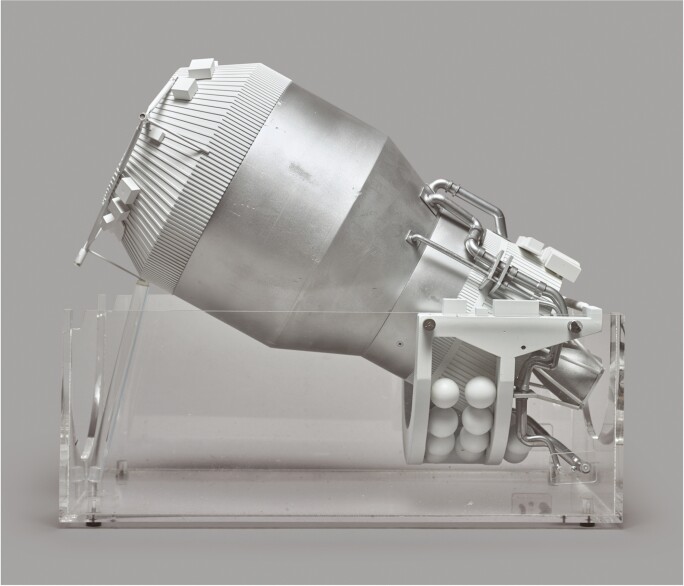Let the Race Begin
From the late 1950s until 1969, the US and USSR were vying to be the first to land a man on the moon.
X-248 Altair Animated Light-Up Contractor's Advertising Model, circa 1960
This fantastic, rare modernist style contractor's advertising model for the Altair rocket stage has it all: the starry sky, pictured on a metal plate behind the rocket, rotates, and the stars light up. A second window reveals a series of rocket features, and rotates on a metal plate. Starting in 1956, NASA & the US military commissioned the Hercules Powder Co. to develop solid-fuel rocket motors; this contract included Altair rocket stages for Vanguard rockets.
Large Scale Apollo Capsule Model in Original Box, circa 1962

This very rare, large cut-away model depicts the Apollo capsule, complete with three seated astronaut figures. Looking closely, you can see the highly-detailed silver Mercury-era spacesuits, complete with NASA meatball patches, name tags and other fine details. Models such as this, complete with highly detailed figures, are few and far between. This is an excellent model manufactured and used by NASA for educational purposes.
Nimbus Satellite Model, circa 1964
This early model of a Nimbus satellite, likely by RCA Aerospace for NASA, is 1:8 scale; and with articulating solar panels, the original wood carrying case and NASA worm label, this model seems like its practically about to take flight. Nimbus satellites were second-generation robotic spacecrafts used for meteorological research and development, including weather forecasting, measurements of the Earth's radiation budget, observations of the Ozone layer and sea ice. This model was likely created by RCA Aerospace for NASA, circa 1964.
Hapke Theoretical Model of the Lunar Surface Reflection, circa 1965
This contractor's model of the lunar surface reflection, as theorized by planetary scientist Bruce Hapke, was manufactured by Boeing circa 1965. Not only is this model very rare, it also has superb story. The lunar surface reflects light in ways that were very puzzling to scientists, as it reflects light back in the direction of the light source, rather than reflecting it uniformly in all directions. Because of this, astronauts walking on the moon had great difficulty viewing details or contrast when the Sun was at their backs. Noted planetary scientist Bruce Hapke was the first person to come up with an adequate theoretical model for this phenomenon, known as lunar photometric function, which was published in his 1963 paper "A Theoretical Photometric Function for the Lunar Surface." (Journal of Geophysical Research, 1 August, 1963). The present model is a 3D rendering of Hapke's theory.
NASA Biosatellite-3 Contractors Model, circa 1969
This very rare, early model of Biosatellite-3 was made by General Electric, circa 1969. The model is designed after the biosatellite NASA used to assess the impact spaceflight may have on living organisms; in particular, NASA looked at the effects of weightlessness and radiation. Biosatellite-3 was the last flight in the Biosatellite Program; it launched in 1969, carrying a pig-tailed monkey named Bonnie. While the mission had to be cut short due to Bonnie's deteriorating health, her voyage gave NASA vital information about whether space travel would prove safe for humans.
The Smithsonian National Air and Space Museum owns an identical model to the one present (the only difference being the contractor's label, which exists in the present lot but not in the museum-owned item).
Man, Meet Moon
In the later part of the 1960s through the 1970s, men finally walk in space – and then they reach the moon.
Oversize Voskhod-2 Rocket Model, circa 1987
Voskhod-2 was a Soviet manned space mission, launched on 18 March 1965 carrying on board Alexei Leonov and Pavel Belyayev. During the second orbit of Voskhod-2, Leonov stepped out of the spacecraft and performed humanity's first Spacewalk, which lasted 12 minutes and 9 seconds. This was a major development in the space race – but following the success, the mission was plagued with a series of dramatic incidents. When Leonov tried to reenter the spacecraft, he discovered his suit was too stiff from over-inflation. He had to bleed air from the suit in order to fit through the airlock, but after finally gaining entry into the spacecraft cabin, the primary hatch wouldn't seal. To compensate, the environmental control system flooded the cabin with oxygen, creating a serious fire hazard.
It gets worse. After a series of system failures, Voskhod-2 finally landed near Perm in the Ural Mountains. Conditions were dire: snow covered the heavy forest, which are home to packs of wolves. The crew spent the night in the woods. Meanwhile, a rescue crew needed to ski in and begin chopping down trees to create a space for a helicopter to land. Finally, the astronauts were saved – but it would be days before the Soviets could remove the capsule itself.
This project presentation model of a Voskhod-2 Rocket was manufactured by NPO Energia, circa 1987. It stands at approximately 72 inches.
Apollo Lunar Module Model, Signed by Six Moonwalkers
This model of the Apollo Lunar Module, produced by the Franklin Mint, is signed by six moonwalkers – one from each mission. Included are the signatures of astronauts Buzz Aldrin, Alan Bean, Edgar Mitchell, David Scott, Charlie Duke and Gene Cernan.
Apollo Spacecraft Contractors Models | Two Models (CSM and LM), Signed By Astronauts from the First Seven Apollo Flights
These vintage models were produced by the Walter J. Hyatt Co. (left) and Precise Models Inc. (right). The inscriptions present on the models are, in mission order, as follows: Walter Cunningham: "First Manned Apollo Mission"; James Lovell: "First Lunar Mission"; Rusty L. Schweickart: "Apollo 9 LMP"; Tom Stafford: "Apollo X"; Michael Collins: "Apollo XI"; Alan Bean: "First Precision Lunar Landing"; and Fred Haise: "Safe Return to Earth After Oxygen Tank Explosion!"
Official Contractor Lunar Lander Model
Issued by the spacecraft builder Grumman, this model closely resembles the Lunar Module which served as a "life boat" during the Apollo 13 mission after the Service Module explosion. An emergency firing of its descent engine put Apollo 13 on a safe trajectory back to Earth and the vehicles oxygen system kept the crew alive during that time. This model was produced by Grumman Aircraft Engineering Corporation (GAEC) of Bethpage, Long Island, NY.
Saturn V Rocket Model, Signed and Inscribed by 15 Different Astronauts
The development of the Saturn V rocket was the result of the US government bringing Wernher von Braun, and about 700 German rocket engineers and technicians to the U.S. as a part of Operation Paperclip. The program was authorized by President Truman, and its primary purpose was to give the U.S. an advantage in the Cold War through the development of intermediate-range and intercontinental ballistic missiles.
This model stands at 43 1/4 inches tall, and features the signatures and inscriptions of 15 different astronauts, including a moonwalker from each lunar landed mission: Frank Borman (Apollo 8), Jim McDivitt (Apollo 9), Rusty Schweickart (Apollo 9), John Young (Apollo 10 and 16), Buzz Aldrin (Apollo 11), Michael Collins (Apollo 11), Alan Bean (Apollo 12), Richard Gordon (Apollo 12), Fred Haise (Apollo 13), James Lovell (Apollo 13), Edgar Mitchell (Apollo 14), Dave Scott (Apollo 15), Al Worden (Apollo 15), Charlie Duke (Apollo 16) and Gene Cernan (Apollo 17).
MAPC-3 (“Mars-3”) Soviet Automatic Interplanetary Probe Project Presentation Model, circa 1987
Built for the Soviet Mars program, the Mars-3 was an unmanned space probe designed to study the surface of Mars. The probe launched in 1971 – six months later, it became the first spacecraft to soft-land on the martian surface. This model, by NPO Lavochkin, is complete with cone antennae, large dish antenna and fully-deploying solar panels. This large model was produced by NPO Lavochkin, circa 1987.
To Infinity, and Beyond
The space race may be over, but exploration continues.
Apollo Soyuz Test project (ASTP) Extra-Large Contractor's Model, circa 1975
Ladies and gentlemen, welcome to the end of the space race – at least, the symbolic ending. Conducted in July 1975, the Apollo-Soyuz Test Project was the first joint US-Soviet space flight, during which the US Apollo Command/Service Module docked with the Soviet Soyuz 19 capsule, and the two crews, consisting of US astronauts Tom Stafford, Vance Brand, and Deke Slayton, and Russian Cosmonauts Alexey Leonov and Valeri Kubasov visited each other’s ships, shared meals, and conducted experiments together. ASTP was the last manned US space mission until the first Space Shuttle flight in 1981.
This extra-large contractor’s model of the docked Apollo and Soyuz spacecrafts was produced by Rockwell International, circa 1975.
Large Custom-Built Shuttle Centaur G Prime Rocket Stage Model, circa 1980
This custom, hand-built model of the canceled Centaur-G Rocket Stage was likely built by General Dynamics, circa 1980. The Centaur-G Prime liquid-fueled rocket stage was designed to boost shuttle payloads out of Earth's low orbit, but NASA ultimately decided to cancel the scheduled flight after the Challenger disaster in 1986.
Hubble Space Telescope Model, circa 1990
This large, highly-detailed model of the Hubble Space Telescope was made by Penwal Industries for NASA, circa 1990. Hubble was the world's first space-based optical telescope, named after the American astronomer Edwin Hubble. When it launched into orbit in 1990, the telescope became the most significant advancement in astronomy since Galileo's refinements of the telescope in the beginning of the 17th century.

